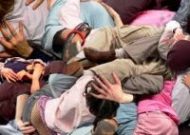Home | Blog | Can dance possibly live up to expectation?
Can dance possibly live up to expectation?
As usual I have let an event lie fallow, let life merge and converge before I revisit said event by engaging in print. The event in question on this occasion is the Keir Choreographic Award and my personal subject for comparative contemplation, my first judo competition.
What struck me was my fellow judo club members’ investment in my performance (in comparison to my usual dance related exploits) which was expressed via a loud collective din, drowning out all thoughts except a will not to disappoint by staying upright at all costs. (When I say all costs, in this case it included a wrenched shoulder and a large floating bursa on the tip of my left elbow.)
I am sometimes perplexed by the amount of interest my burgeoning physical endeavour has garnered. Why is it so easy for people to jump on board when it comes to sport? Why does it garner so much media attention? You just have to inspect the latest cricket ball tampering saga to see what I mean.
I could speculate that there are set rules as to how sporting events are conducted and that there can only ever be two outcomes, either winning or losing, but maybe this is too simplistic.
I do know that the Keir Choreographic Award has generated great attendances and that the designated People’s Choice Award has required more from an audience than passive viewing.
After the last awards there was much talk amongst the dance community as to what actually constitutes dance. This time around I expressed my pleasure at the inclusion of humour in Nana Bilus Abaffy’s Post Reality Vision, only to be told that it shouldn’t have been included because it wasn’t dance. What was the carefully staged video? It rendered the soloists, both animate and inanimate, as a chorus. Was that not choreography?
One thing that definitely set the Keir apart from a football match was the inclusion of copy to clarify the framework for appreciation. As usual, I don’t actually read the blurb advertising the individual maker’s intent, and after reading the pamphlet I am glad I stuck to my routine of self realisation because if I had read the program notes ahead of time I would’ve been tempted to walk out before the show had begun. Why were so many of the program notes both confusing and unnecessarily convoluted?
From this program I witnessed the strong technical ability of dancer Melanie Lane in her solo Personal Effigies which featured her body in multiple manifestations. With the use of a mirror, Lane was able to grow extra limbs and contort her body by the continuous manipulation of the reflective surface. I was reminded of Sue Healey’s [The] Curiosities (2008-12) which placed the body on display like museum pieces. In Personal Effigies I surmised Lane had placed herself en vue as the exotic or alien other. Lane’s program preamble prompted me to think outside my original confines by alluding to the exploration of her body as more than a mere object of appreciation, to include its ability for the substance or soul to mutate in tandem with each of her exterior manifestations. I was then prompted to think of her as a shape shifter and to contemplate the ways in which we all continually shape shift out of social necessity.
Luke George’s choreography Public Action was a successful demonstration of inclusivity well defined and realised, in print and on show, within the parameters of the competition. With one simple premise, the shifting and snowballing of a single audience member growing to a small chaotic ensemble. From the nosebleeds to the stage floor, Luke was able to shift the stage space and we all became players in his work. The visual wreckage unfolding from the front row was a thing of beauty.
With Amrita Hepi’s A Caltex Spectrum I thought I had spied a post-apocalyptic landscape with the dancers appearing like souped-up Mad Max (1979) warriors. Hepi’s choreographic strength lay in the provision of an outlet for the dancers’ individual virtuosities, creating a highly addictive physicality, which unavoidably generated excitement. Hepi’s use of brightly lit, almost fluorescent mouth guards, consolidated a futuristic setting conjuring up images of Tron (1982), the film where the characters’ selves were able to permeate and inhabit the digital world. Yet, upon reading Hepi’s explanation, I found myself slightly alienated by what I had experienced because of my inability to conceive her intent. I wondered if her elusive text was an extension of the work itself and not an early entry into it.
Ultimately, after the show I pondered this ‘competition’ format for arts patronage. How do we decide that one work is better than … another? Is it that the artist has best realised their intent? Is it the technical accomplishment? Or is it in the ability for the artist to supply an audience with what they think they need (or expect) from that event?
I want to see dance. I want it to be clever; I want to be entertained and possibly moved. Can dance possibly live up to expectation? Maybe we are asking too much and that’s why sport garners so many bums on seats.

